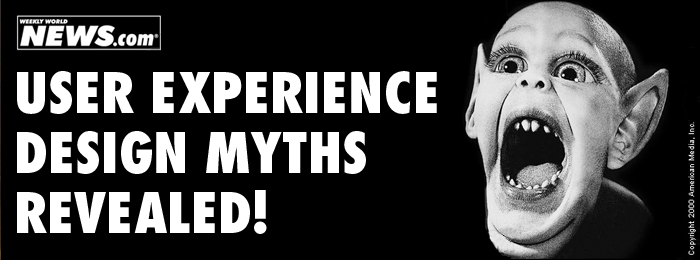Over thousands of years, people have invented mythical creatures—unicorns, the Loch Ness Monster, Bat Boy—and in sticking with tradition, they continue to today. Enter the most recent to join the ever-growing list of folklore: people who don’t scroll.Similar to the aforementioned mythical creatures (all backed by eyewitness accounts) there is an assortment of user-experience design myths and misconception. Here I will address just a few of my favoritesthat keep resurfacing, and ask all of our designer friends tojoin us on Facebook and share some of your favorite UX myths.
Myth #1: Usability means giving the user as many options as possible.Typically, options are a good thing. However, there is a fine line between giving the user valuable options on a website or application, and overwhelming them with competing links and call-outs that could confuse, or worse, paralyze the user. It is the duty of the UX designer to teach or train the user how to navigate the interactive environment and successfully guide their experience while delivering the message in the way that it was intended. Doing away with unnecessary or overwhelming options can help the user make better decisions, which will lead to a more rewarding and satisfying experience for both parties.
Myth #2: UX Design is all about making the website look good.Believe it or not, if you ask, “What is design?” you will likely get more than one answer. When it comes to UX design, the reply will often times include “decorating” or “styling” a website. But UX design delves much deeper than color and aesthetics; it’s equal parts of form and function. Just as human ergonomics need to be considered when designing a bicycle or a fighter jet cockpit, good design will consider how we think and behave in order to guide the user to a successful experience.
“Design is not just what it looks like and feels like. Design is how it works.” –Steve Jobs
Myth #3: You don’t need content to design the page.Content is king. Creating wireframes is a step in the design process, but not necessarily the first and never the last. Focusing on the actual content of the site and communicating it in a customized environment will resonate with the user and better define the message. Every piece of unique content presents its own unique problem that needs a solution, and in order to develop the best possible solution, it is necessary to know the problem.
Myth #4: I can pinch and zoom, so it is optimized.There is only one web. We don’t have a desktop web, a tablet web, an e-reader web, and a mobile web. However, we do have the responsibility to our users of delivering the message and experience across all platforms and media types. Over the last two years the web has seen a 162% increase in mobile device connectivity, and is predicted to replace the desktop computer, as the primary device used to connect to the web, by 2014. Still, most websites put little, if any, effort into catering to the mobile user, or future proofing for 2014. It is time to make the mobile device, and its user, our first priority. To give the best and most consistent experience across both media types, I would recommend designing one website then use media queries to help adjust the page layout for different devices. This technique combined with progressive enhancement is what has become known as responsive design.
Myth #5: People don’t know to scroll (a personal favorite)“Above the fold” is a newspaper term referring to the upper-half of the front page, where we would find the most important or engaging content. This term has been ported to the Internet and now refers to the area of the webpage first seen after it loads, before the user scrolls. Nearly 20 years ago the worldwide web was still very new. Vertical scrolling had not yet become common practice, and was considered a chore. So, borrowing from its printed sibling, the web designer would work to keep as much content as possible “above the fold.” However, with the introduction of scroll wheels, broadband, touch displays, and momentum feedback, scrolling has taken over as a preferred way to navigate a page, as opposed to clicking through sections of fragmented content.Cxpartners, a customer experience consultancy, conducted a six-year study (2009) of over 800 testing sessions and found only three occasions where the fold was seen as a barrier. Yet, we still hang on to the idea that users do not know to scroll or know how to scroll, or that they need giant arrows telling them to scroll. This can result in unnecessary visual clues and crammed content that can dismantle the information hierarchy, which is the most important tool used to communicate to the user how to engage the site. I’m not saying ignore the fold altogether; it needs to be dealt with just as any other constant variable does. However, don’t let this myth scare you into letting it become more important than the message.
Just as there are a lot more than three above listed mythical creatures, there are plenty more UX design myths. This is only a small selection of a few common ones. I urge you to visit ourUX Design Myths Facebook thread and share your favorite misconceptions.
